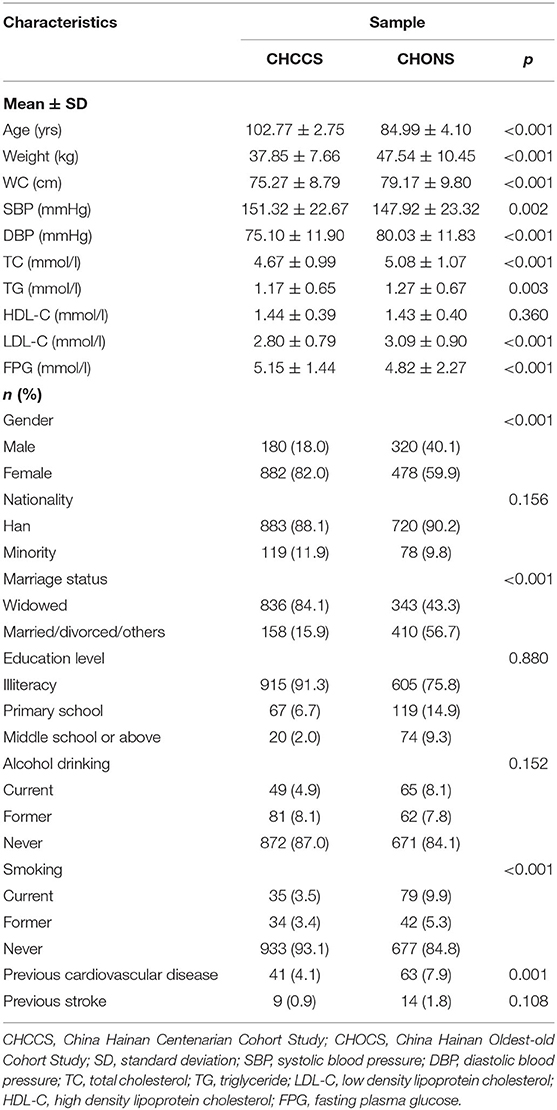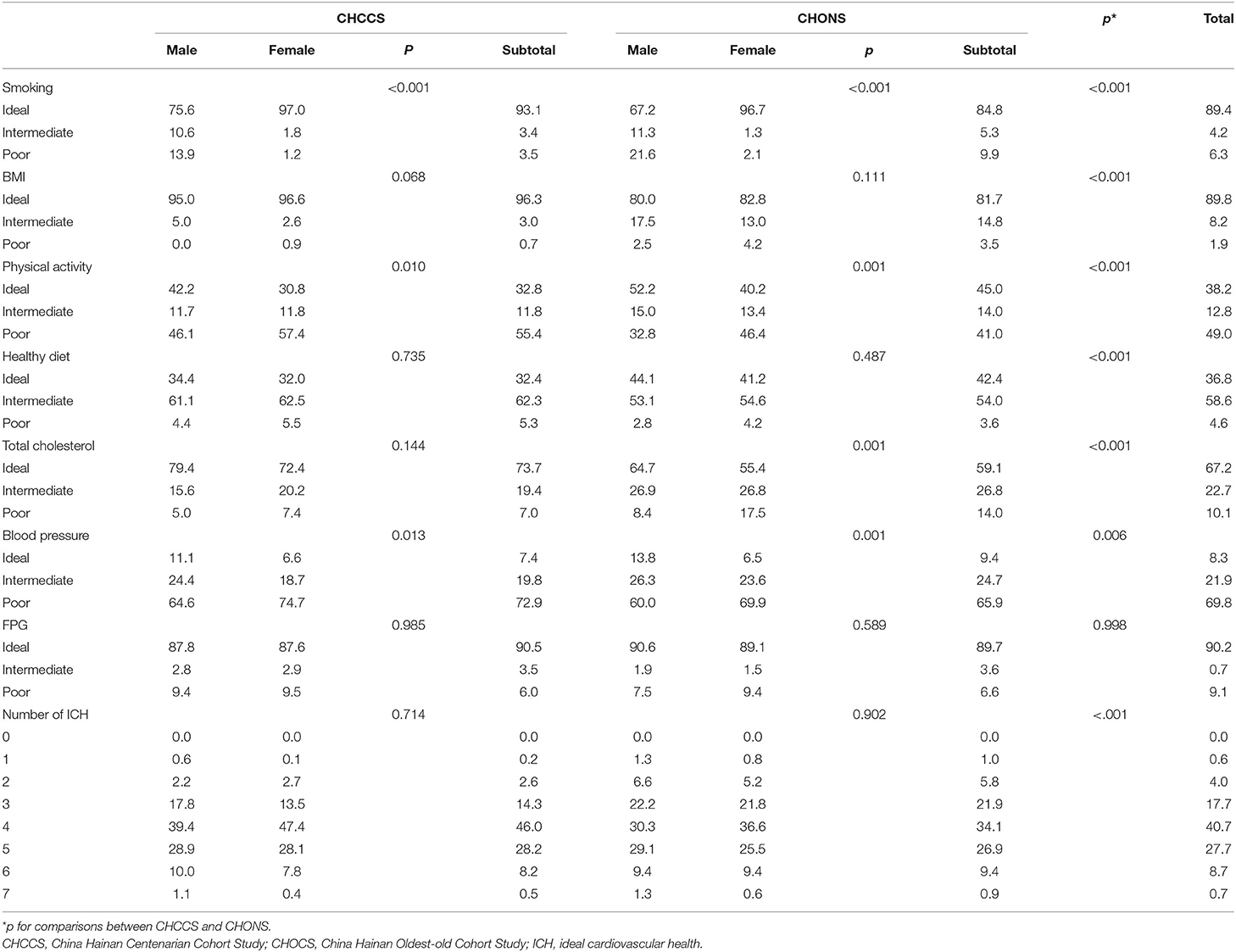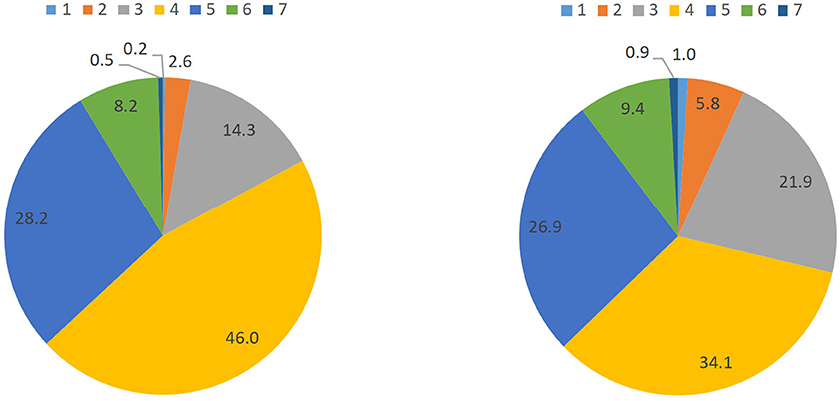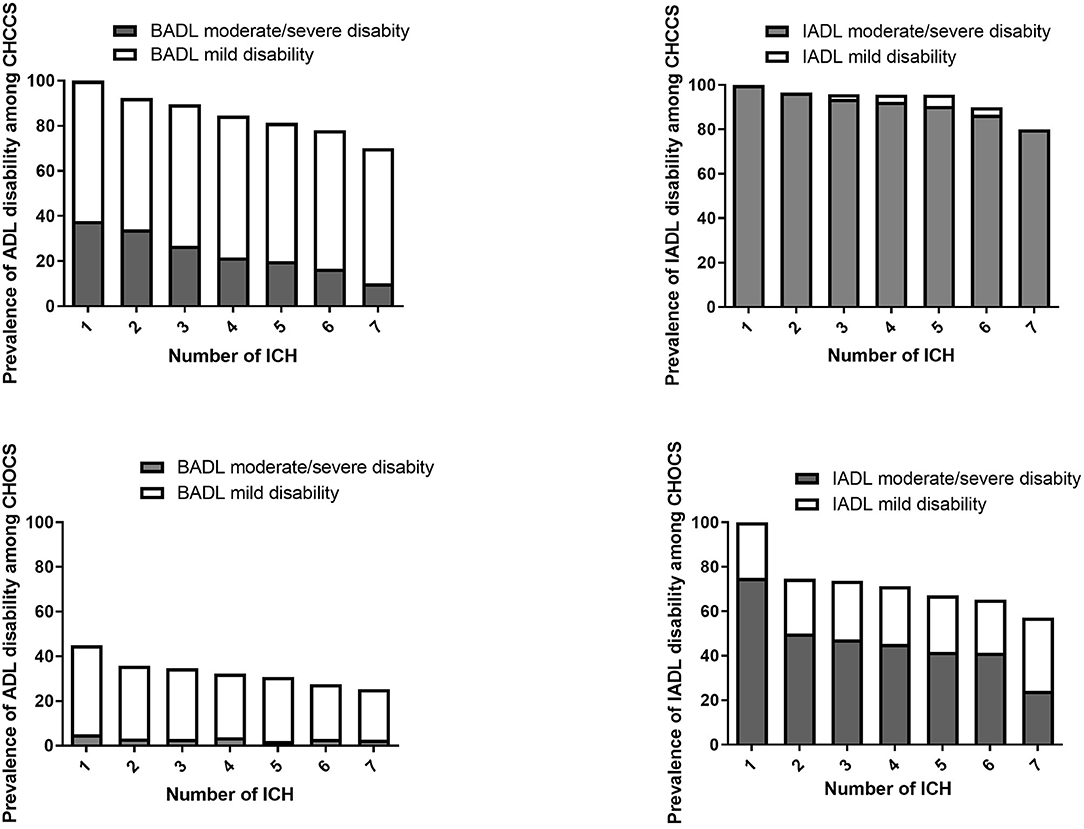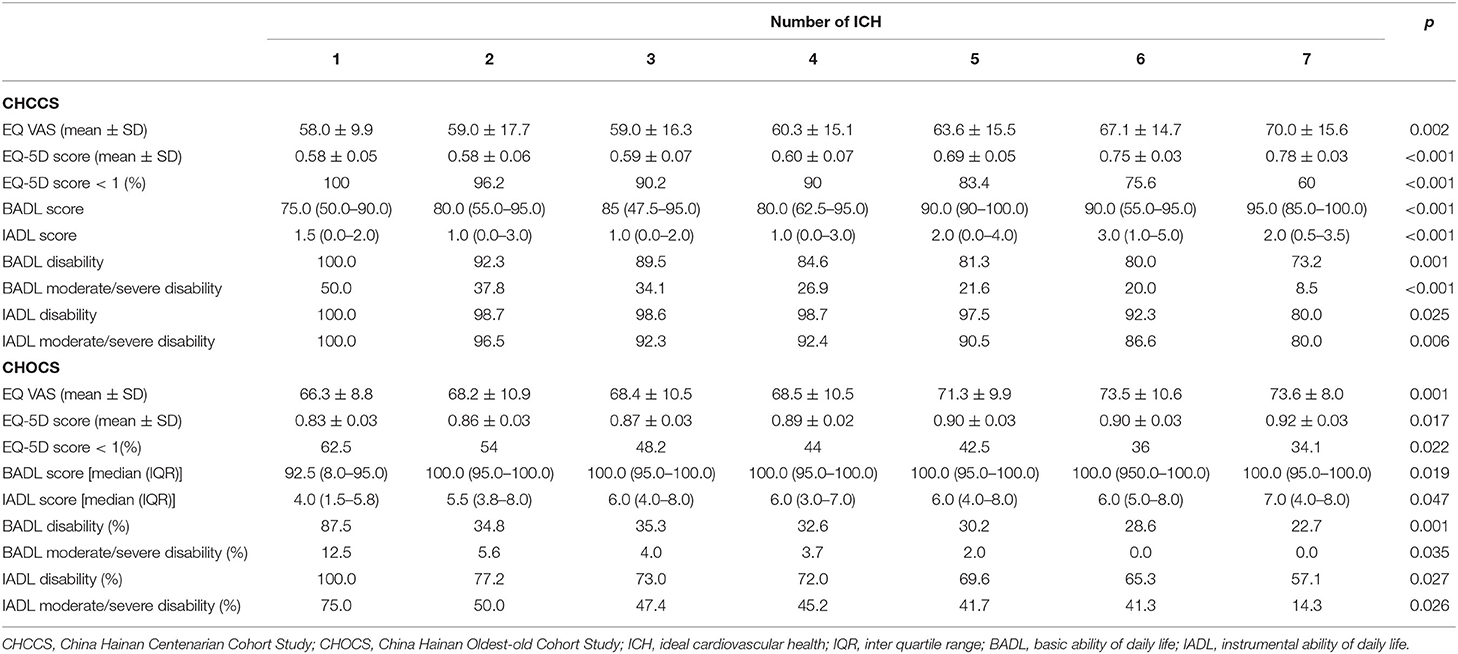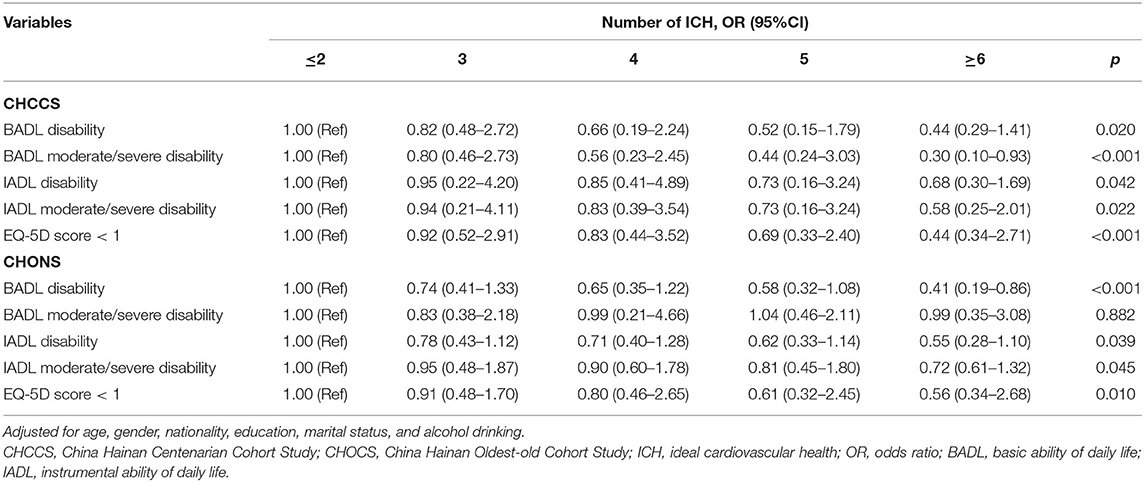- 1Department of Statistics and Epidemiology, Graduate School of Chinese People's Liberation Army General Hospital, Beijing, China
- 2Health Service Department, Chinese People's Liberation Army General Hospital, Beijing, China
- 3The 1st Medical Center, Department of Disease Prevention and Control, Chinese People's Liberation Army General Hospital, Beijing, China
- 4National Clinical Research Center for Geriatrics Diseases, Beijing Key Laboratory of Aging and Geriatrics, State Key Laboratory of Kidney Diseases, Institute of Geriatrics, Second Medical Center of Chinese People's Liberation Army General Hospital, Beijing, China
- 5Foreign Language Department, Graduate School, Graduate School of Chinese People's Liberation Army General Hospital, Beijing, China
Objective: This study aimed to investigate the distribution of ideal cardiovascular health (ICH) indicators among the oldest-old and centenarians and explore their relationships with disability and health-related quality of life of this population.
Methods: One thousand two centenarians from China Hainan Centenarian Cohort Study and 798 oldest-old from the China Hainan Oldest-old Cohort study were the target subjects in this analysis. ICH status, disability, and health-related quality of life of study subjects were assessed.
Findings: The median value of ICH indicators among centenarians and the oldest-old is 4 (4–5) and 3 (3–5), respectively. The ICH indicators with the highest percentage of ideal level/status are fasting plasm glucose (FPG) (90.2% of study subjects are at the ideal level), BMI (89.8% of study subjects are at the ideal level), and smoking (89.4% of study subjects are at the ideal status). The disability rates of basic activities of daily living (BADL) and instrumental activities of daily living (IADL) decrease with the increasing number of ICH indicators. The EQ VAS and EQ-5D score show an increasing trend along with the increasing number of ICH indicators (p < 0.05). After adjusting related covariates, the risk of disability and lower health-related quality of life decreased gradually as the number of ICH metrics increased (p < 0.05).
Interpretation: The ICH metrics of centenarians and oldest-old were at a relatively good level, and there was a strong and independent relationship between the number of ICH indicators and disability as well as the lower health-related quality of life.
Introduction
Cardiovascular diseases are a major public health problem affecting not only health but also health-related quality of life all around the world (1, 2). It is the leading cause of mortality in China and the cardiovascular disease burden increases as the population ages. The latest burden of disease report in China shows that ischemic heart diseases and stroke are the top causes of death (3). Understanding and identifying health risk factors is particularly important for the prevention and control of cardiovascular diseases. In 2010, the American Heart Association (AHA) developed new criteria to define risk factors for cardiovascular disease and to assess whether the cardiovascular system is in an ideal state using the ideal cardiovascular health (ICH) metrics. ICH metrics consists of seven factors and plays a major role in assessing cardiovascular health risks (4). Numerous studies have shown that keeping people in ICH status is the cornerstone to reducing the cardiovascular disease incidence (5, 6). It has also been pointed out that the status of ICH is not only related with cardiovascular diseases, but also related with diabetes, depression, cancer, and other diseases or health outcomes (7–9). Better ICH status is closely related to a higher health-related quality of life and a lower disability rate (10–12).
However, most current studies are conducted upon adults or young elderly (11, 13). There is a lack of understanding of ICH status for the elderly who are above 80 years old. Most of the studies on the elderly population focus on hospitalized patients or the elderly from senior care facilities; little knowledge is known about the general elderly population (14). Therefore, this study aims to understand the characteristics of ICH metrics distribution and their relationship with disability and health-related quality of life in the centenarian and the oldest-old population by analyzing the information collected from China Hainan Centenarian Cohort Study (CHCCS) and China Hainan Oldest-old Cohort study (CHOCS).
Study Design and Methods
Study Population
The study subjects were recruited from the CHCCS and CHOCS. The framework of study design has been published in the International Journal of Epidemiology (15). From January 2014 through to December 2016, we surveyed a total number of 1,002 eligible centenarians who were more than 100 years old from 18 cities and counties in Hainan province, which is the province with the highest proportion of longevity population in China. Meanwhile, a multi-stage sampling method was used to select a group of oldest-old subjects who were 80–100 years old. Probability proportional to size (PPS) sampling was used to determine the locations from the district level then to the village and community level. A total number of 798 oldest-old who were between 80 and 100 years old were included.
Investigation Method
We had a face-to-face interview with each study subject. All the interviewers were medical and nursing staff from Hainan Hospital affiliated to the Chinese PLA General Hospital. A health questionnaire was used to collect detailed demographic and sociological characteristics, disease history, family history, lifestyle, disability, and health-related quality of life for all subjects. Height, weight, and blood pressure were measured by trained nurses. The body length of subjects with kyphosis was measured instead of height. Fasting venous blood (over 8 h of fasting) was collected during 7–8 a.m. and sent to the department of biochemistry, Hainan Hospital, within 4 h, to test the level of total cholesterol (TC), triglyceride (TG), high density lipoprotein cholesterol (HDL-C), low density lipoprotein cholesterol (LDL-C), and fasting blood glucose (FPG).
Definitions
The age of a subject is calculated as the differences between the date of interview and their date of birth (validated through the subject's ID card information) in years. Centenarians are subjects who were more than 100 years old on the day of survey. The oldest-old are the subjects who were 80–99 years old on the day of the survey. The ethnicity of a subject is classified as either Han or minority. Marital status is divided as widowed or not (including married, divorced, or other). The education level is classified according to the total years of education: illiteracy (0 years), primary school (0–6 years), and middle school and above (7–12years). Body mass index (BMI) is calculated as weight in kilograms divided by the square of height in square meters. Alcohol drinking status is classified into three categories: current, former, and never. Coronary heart disease and stroke history is determined from their medical records output from Grade II and III hospitals.
The assessment of disability includes two aspects: basic ability of daily life (BADL) and instrumental ability of daily life (IADL). The BADL is measured by the Barthel index, which includes 10 items (including feeding, bathing, dressing, bowel and bladder control, toilet use, chair transferring, dressing, stair climbing, and ambulating) with a total score of 100. The IADL is measured by Lawton scale, which includes eight items (namely phone use, cooking, washing, taking medication, shopping, housekeeping, transportation, and financial ability) with a total score of eight. The assessment outcome of disability used in this study is presented in two ways-two levels: complete self-care and disability; and four levels: complete self-care, mild disability, moderate disability, and severe disability. The level of BADL and IADL is shown in Appendix Table 1 (16–18).
Quality of life was assessed by the EQ-5D-3L scale (which was developed by EuroQol Group). The EQ-5D-3L is composed of two parts: a self-reported scale with five elements, namely mobility, self-care, pain/discomfort, daily activities, and anxiety/depression, and a visual analog scale (VAS) which reflects current overall health on a scale from 0 to 100. The EQ-5D score is calculated using the Chinese value sets (19).
ICH metrics are defined by the AHA expert panel (4) and modified to the characteristics of the Chinese population. The ICH metrics include seven items: smoking status, BMI, physical activity level, diet, blood pressure level, total cholesterol level, and FPG level. For each ICH metric, there are three levels of cardiovascular health status: poor, intermediate, and ideal (Appendix Table 2). The quality of a diet is evaluated by the consumption level of fish, vegetables, red meat, eggs, and preference for salty food. ICH is assessed among participants who have no history of coronary heart diseases or stroke.
Ethics Approval and Consent to Participate
This study was approved by the Biomedical Ethics Committee of Chinese PLA general hospital. Written informed consent was obtained voluntarily from each participant.
Statistical Analysis
Survey information was entered and stored using statistical software Epidata3.1. The mean value and standard deviation (SD) were calculated for each continuous variable and the percentage (n %) distribution was calculated for each categorical variable. Variance analysis or a non-parametric test was used to compare continuous variables. Chi-square test was used to compare categorical variables. Multivariable logistic regression was used to predict the OR (95% CI) of ICH associated with each dependent variable. The ICH status of five levels (0–2, 3, 4, 5, and 6–7) was used as the outcome variable. Covariates included gender, age, ethnicity, culture, marital status, and alcohol consumption. ADL disability, moderate to severe ADL disability, IADL disability, moderate to severe IADL disability, and low EQ-5D were used as binary dependent variables, respectively.
Results
There are 1,002 centenarians and 798 oldest-old participants in this study. The average age is 102.77 and 84.99 years for each group. Percentages of female participants, widowed participants, and illiterate participants in centenarians are all higher than in the oldest-old. The average weight, waist circumference (WC), and average level of, DBP, TC, TG, and LDL-C are all lower in centenarians than in oldest-old, whereas systolic blood pressure and fasting blood sugar level are higher. Results are shown in Table 1.
Distribution of ICH Metrics in Centenarians and Oldest-Old
The distribution of ICH metrics in centenarians and oldest-old is presented in Table 2 and Figure 1. The distribution of ICH metrics among centenarians is more centralized than that in the oldest-old. The median levels of ICH metrics among centenarians and oldest-old are 4 (4–5) and 3 (3–5), respectively. 8.7% of the centenarians have more than 6 ICH metrics at the ideal levels; 74.2% have 4–5 ICH metrics at the ideal levels. 10.3% of the oldest-old have more than 6 ICH metrics at the ideal levels, while 82.9% have 3–5 ICH metrics at the ideal levels. FPG (90.2%), BMI (89.8%), and smoking (89.4%) have the highest percentage of being at the ideal level while blood pressure (8.3%) and BMI (1.9%) had the lowest percentage (8.3%) (Table 2). Centenarians have a higher percentage of being at the ideal levels in ICH metrics of smoking (93.1 vs. 84.8%), BMI (96.3 vs. 89.8%), and TC (73.7 vs. 59.1%), meanwhile the oldest-old have a higher percentage of being at the ideal levels in physical activity (45.0 vs 32.8%) and healthy diet (41.2 vs. 32.4%).
The Relationship Between the Level of ICH Metrics and Disability
39.1% of total participants are complete BADL self-care and 12.8% are IADL self-care. Disability rate is much higher in centenarians than in the oldest-old. Male participants have better ADL than female, both in centenarians and oldest-old (p < 0.05) (Appendix Table 3).
Disability rates of BADL and IADL decrease as the number of ICH metrics increases (Figure 2). Among the centenarians, BADL disability decreases from 100.0 to 73.2% as the number of ICH increases from 1 to 7. The IADL disability rate decreases from 100 to 80.0% and is largely driven by subjects with moderate to severe IADL disability. The disability rates among the oldest-old also show a downward trend as the number of ICH metrics increases.
The Relationship Between the Number of ICH Metrics and Health-Related Quality of Life
The EQ VAS and EQ-5D score are higher in the oldest-old than in centenarians (p < 0.05). The EQ VAS and EQ-5D score show an increasing trend with the number of ICH metrics increases (p < 0.05) (Table 3).
Multivariable Analysis
Multivariable regression was used to analyze the ORs of ICH metrics for disability and lower health-related quality of life (defined as having the EQ-5D score < 1). Subjects who had been diagnosed with coronary diseases or stroke were removed from the association analysis. After adjusting related covariates, the risk of disability and lower health-related quality of life decreased gradually with the increase of ICH numbers (p < 0.05). When using the moderate to severe disability as the dependent variables, the ORs also decrease as the number of ICH metrics increases (p < 0.05) (Table 4).
Considering there is a close relationship between physical activity and disability, we removed the physical activity from the ICH metrics in the sensitivity analysis. The main results and trends remained unchanged (Appendix Table 4).
Discussion
This study investigated the distribution of ICH metrics in oldest-old and centenarians and explored the association between the level of ICH metrics and disability and health-related quality of life. The results show that the centenarians and the oldest-old tend to have relatively high level of ICH metrics and there is a strong and independent association between the number of ICH metrics and disability and lower health-related quality of life. It is reported from previous studies that the overall level of ICH metrics among centenarians and the oldest-old was relatively higher than adults or young elderly (20–23). Our results showed that 8.7% of the centenarians and 10.3% of the oldest-old had more than 6 ICH metrics at the ideal level, while the percentage was only 4.3% among those aged ≥45 based on a nationally representative sample of 96,121 Chinese adults (13). The status of smoking and BMI are impacted by alterable behaviors and the percentage of ideal status for these two metrics nearly reach 90%, but the percentage of ideal level of physical activity is still very low. This finding is consistent with the results from some previous research from which it is reported that the population smoking rate increases at the age of 20 through to 60 and then decreases as the population gets older (24, 25). The percentage of ideal level of diet is <40.0%. It is mainly driven by the low consumption of dairy products which is common in China, especially among the aged population (26). The percentage of ideal level of FPG and TC is relatively high whereas the percentage of ideal blood pressure level is low (8.3%). We have seen similar results in previous studies that the glucose and TC levels are well-managed and controlled in an older population (27, 28). This finding may be explained by survival bias. That is, the elderly with metabolic disorders died before the age of 80. In addition, a series of studies show that metabolic abnormalities peak before reaching the age of 80, then blood sugar and lipid levels gradually decline. The mechanism is still unclear, which may be related to nutrition and slow metabolism in the older population (29–31). Hypertension is one of the most important risk factors for cardiovascular diseases. A study of 1.3 million survey results shows that the prevalence of hypertension in China is high and the control rate is low (32). Our study also shows the low percentage of ideal blood pressure levels among all subjects. This suggests it is important to improve proper treatment and control measures of hypertension.
Our results show that as the number of ICH metrics increases, both disability and lower health-related quality of life rate decreases. Some previous research has pointed out that the poor ICH status is associated with an increasing prevalence of cardiovascular diseases, including myocardial infarction, atrial fibrillation, heart failure, stroke, etc. (5, 6). Meanwhile, other researchers suggest that ICH metrics are related with other diseases and symptoms, including diabetes, non-alcoholic fatty liver disease, and depression (8, 9). However, previous research shows little evidence about the association between ICH metrics and disability, especially IADL. We investigated the relationship, and our results indicate that ICH metrics are associated with both BADL and IADL disability, especially moderate to severe disability. The effect of one single metric, either health behavior or health factor, on disability or health-related quality of life is weak, while the effect of the combined metrics is strong. This suggests that the ICH metrics are a good indicator for screening high-risk disability in the elderly (11, 12).
ICH status is not only related to cardiovascular disease prevention, but also to multiple other health outcomes. The correlation between single risk factor and disability is weak, but the correlation between the combination ideal cardiovascular health factors and disability or health-related quality of life shows a statistical difference, and this correlation is more significant for moderate to severe disability.
Our study benefits from some unique aspects. First, this is the first survey about the distribution of ICH metrics and association with both disability and health-related quality of life based on elderly aged over 80 years old. Secondly, most previous studies focused on inpatients or institutionalized elderly, our study recruited community-based participants with a large sample size. In addition, we investigated both BADL and IDAL to understand disability more comprehensively. However, there were several limitations in this study. First, all the participants are from Hainan province, making it hard to generalize across other oldest-old and centenarian groups. Second, the association analysis is based on cross-sectional design that does not provide a strong causal inference. And the application of ICH metrics was modified to accommodate the lifestyle and characteristics of the older population in China. Lastly, the effect of survival bias might be very strong in the study samples, which may have effects on the results.
Conclusions
The results show that the overall level of ICH metrics of centenarians and oldest-old is relatively good and there is a strong and independent relationship between ICH metrics and both disability and lower health-related quality of life. The results highlight the importance of cardiovascular prevention even at 80 years and above.
Perspectives
Core Clinical Competencies in Medical Knowledge
The centenarians and the oldest-old had a better level of ICH metrics. And there was a strong and independent relationship between ICH metrics with both disability and lower health-related quality of life at this age group.
Translational Outlook
Even at the age of 80 or above, attention should be paid to maintain better ICH status. This was closely related with the self-care and better health-related quality of life, which was very important in the later life.
Data Availability Statement
The original contributions presented in the study are included in the article/supplementary material, further inquiries can be directed to the corresponding author/s.
Ethics Statement
The studies involving human participants were reviewed and approved by the Biomedical Ethics Committee of Chinese PLA General Hospital. The patients/participants provided their written informed consent to participate in this study.
Author Contributions
ML, FK, and SY were involved in statistical analysis and result interpretation. SW and WZ were involved in manuscript drafting. YH was involved in study design, manuscript drafting, and review. All authors contributed to the article and approved the submitted version.
Conflict of Interest
The authors declare that the research was conducted in the absence of any commercial or financial relationships that could be construed as a potential conflict of interest.
Publisher's Note
All claims expressed in this article are solely those of the authors and do not necessarily represent those of their affiliated organizations, or those of the publisher, the editors and the reviewers. Any product that may be evaluated in this article, or claim that may be made by its manufacturer, is not guaranteed or endorsed by the publisher.
Acknowledgments
We want to express our appreciation to the staff and participants at the China Hainan Centenarian Cohort Study (CHCCS) and China Hainan Oldest-old Cohort Study (CHOCS).
Supplementary Material
The Supplementary Material for this article can be found online at: https://www.frontiersin.org/articles/10.3389/fcvm.2021.603877/full#supplementary-material
Abbreviations
BADL, basic ability of daily life; BMI, body mass index; CI, confidence interval; CHCCS, China Hainan Centenarian Cohort Study; CHOCS, China Hainan Oldest-old Cohort Study; DBP, diastolic blood pressure; FPG, fasting plasma glucose; HDL-C, high density lipoprotein cholesterol; IADL, instrumental ability of daily life; ICH, ideal cardiovascular health; IFG, impaired fasting glucose; LDL-C, low density lipoprotein cholesterol; OR, odds ratio; SBP, systolic blood pressure; TC, total cholesterol; TG, triglyceride; VAS, visual analog scale.
References
1. Gheorghe A, Griffiths U, Murphy A, Legido-Quigley H, Lamptey P, Perel P. The economic burden of cardiovascular disease and hypertension in low- and middle-income countries: a systematic review. BMC Public Health. (2018) 18:975. doi: 10.1186/s12889-018-5806-x
2. Leong DP, Joseph PG, Mckee M, Anand SS, Teo KK, Schwalm JD, et al. Reducing the global burden of cardiovascular disease, part 2: prevention and treatment of cardiovascular disease. Circ Res. (2017) 121:695–710. doi: 10.1161/CIRCRESAHA.117.311849
3. Zhou M, Wang H, Zeng X, Yin P, Zhu J, Chen W, et al. Mortality, morbidity, and risk factors in China and its provinces, 1990–2017: a systematic analysis for the Global Burden of Disease Study 2017. Lancet. (2019) 394:1145–58. doi: 10.1016/S0140-6736(19)30427-1
4. Lloyd-Jones DM, Hong Y, Labarthe D, Mozaffarian D, Appel LJ, Horn LV, et al. Defining and setting national goals for cardiovascular health promotion and disease reduction: the American Heart Association's strategic Impact Goal through 2020 and beyond. Circulation. (2010) 121:586–613. doi: 10.1161/CIRCULATIONAHA.109.192703
5. Gaye B, Tafflet M, Arveil D, Montaye M, Kee F, Amouyel P, et al. Ideal cardiovascular health and incidence of cardiovascular disease: heterogeneity across event phenotype and contribution of multiple biomarkers. The prime study. Atherosclerosis. (2017) 263:e189–90. doi: 10.1016/j.atherosclerosis.2017.06.607
6. Xanthakis V, Enserro DM, Murabito JM, Polak JF, Kai CW, Januzzi JL, et al. Ideal cardiovascular health: associations with biomarkers and subclinical disease and impact on incidence of cardiovascular disease in the Framingham Offspring Study. Circulation. (2014) 130:1676–83. doi: 10.1161/CIRCULATIONAHA.114.009273
7. España-Romero V, Artero EG, Lee DC, Sui X, Bareth M, Ruiz JR, et al. A prospective study of ideal cardiovascular health and depressive symptoms. Psychosomatics. (2013) 54:525–35. doi: 10.1016/j.psym.2013.06.016
8. Joseph JJ, Tcheugui JBE, Carnethon MR, Bertoni AG, Shay CM, Ahmed HM, et al. The association of ideal cardiovascular health with incident type 2 diabetes mellitus: the multi-ethnic study of atherosclerosis. Diabetologia. (2016) 59:1–11. doi: 10.1007/s00125-016-4003-7
9. Zhu S, Shi J, Ji C, Yang G, Xing J, Zhu F, et al. Association of the ideal cardiovascular behaviors and factors with the incidence of non-alcoholic fatty liver disease: a prospective study. Eur J Gastroenterol Hepatol. (2018) 30:578–82. doi: 10.1097/MEG.0000000000001069
10. Allen NB, Badon S, Greenlund KJ, Huffman M, Hong Y, Lloyd-Jones DM. The association between cardiovascular health and health-related quality of life and health status measures among U.S. adults: a cross-sectional study of the National Health and Nutrition Examination Surveys, 2001–2010. Health Quality Life Outcomes. (2015) 13:152. doi: 10.1186/s12955-015-0352-z
11. Garcíahermoso A, Ramírezvélez R, Ramirezcampillo R, Izquierdo M. Relationship between ideal cardiovascular health and disability in older adults: the Chilean National Health Survey (2009–10). J Am Geriatr Soc. (2017) 65:2727–32. doi: 10.1111/jgs.15139
12. Odom EC, Fang J, Matthew Z, Latetia M, Fleetwood L. Associations between cardiovascular health and health-related quality of life, behavioral risk factor surveillance system, 2013. Prev Chronic Dis. (2016) 13:E99. doi: 10.5888/pcd13.160073
13. Yufang B, Jiang Y. He J, Xu Y, Wang LM, Xu M, et al. Status of cardiovascular health in Chinese adults. J Am Coll Cardiol. (2015) 65:1013–25. doi: 10.1016/j.jacc.2014.12.044
14. Wu T, Lu L, Luo L, Guo Y, Ying L, Tao Q, et al. Factors associated with activities of daily life disability among centenarians in rural Chongqing, China: a cross-sectional study. Int J Environ Res Public Health. (2017) 14:1364. doi: 10.3390/ijerph14111364
15. He Y, Zhao Y, Yao Y, Yang S, Li J, Liu M, et al. Cohort profile: the China Hainan Centenarian Cohort Study (CHCCS). Int J Epidemiol. (2018) 47:694–5. doi: 10.1093/ije/dyy017
16. Mahoney FI, Barthel DW. Functional evaluation: the barthel index. Md State Med J. (1965) 14:61–5. doi: 10.1037/t02366-000
17. Lawton MP, Brody EM. Assessment of older people: self-maintaining and instrumental activities of daily living. Gerontologist. (1969) 9:179–86. doi: 10.1093/geront/9.3_Part_1.179
18. Li F, Li D, Yu J, Jia Y, Jiang Y, Chen T, et al. Barthel index as a predictor of mortality in patients with acute coronary syndrome: better activities of daily living, better prognosis. Clin Interv Aging. (2020) 15:1951–61. doi: 10.2147/CIA.S270101
19. Szende A, Janssen B, Cabases J. Self-Reported Population Health: An International Perspective Based on EQ-5D. Dordrecht: Springer. (2014). p.1. doi: 10.1007/978-94-007-7596-1
20. Kim JI, Sillah A, Boucher JL, Sidebottom AC, Knickelbine T. Prevalence of the American Heart Association's “ideal cardiovascular health” metrics in a rural, cross-sectional, community-based study: the heart of New Ulm Project. J Am Heart Assoc Cardiovasc Cerebrovasc Dis. (2013) 2:e000058. doi: 10.1161/JAHA.113.000058
21. Oikonen M, Laitinen TT, Magnussen CG, Steinberger J, Sinaiko AR, Dwyer T, et al. Ideal cardiovascular health in young adult populations from the United States, Finland, and Australia and its association with cIMT: the International Childhood Cardiovascular Cohort Consortium. J Am Heart Assoc Cardiovasc Cerebrovasc Dis. (2013) 2:e000244. doi: 10.1161/JAHA.113.000244
22. Ren J, Guo X, Lu Z, Zhang J, Tang J, Chen X, et al. Ideal cardiovascular health status and its association with socioeconomic factors in Chinese adults in Shandong, China. BMC Public Health. (2016) 16:942. doi: 10.1186/s12889-016-3632-6
23. Henriksson P, Henriksson H, Gracia-Marco L, Labayen I, Ortega F, Huybrechts I, et al. Prevalence of ideal cardiovascular health in European adolescents: the HELENA study. Int J Cardiol. (2017) 240:428–32. doi: 10.1016/j.ijcard.2017.03.022
24. Tian X, Tang Z, Jiang J, Fang X, Wu X, Han W, et al. Effects of smoking and smoking cessation on life expectancy in an elderly population in Beijing, China, 1992–2000: an 8-year follow-up study. J Epidemiol. (2011) 21:376–84. doi: 10.2188/jea.JE20110001
25. Liu S, Zhang M, Yang L, Li Y, Wang L, Huang Z, et al. Prevalence and patterns of tobacco smoking among Chinese adult men and women: findings of the 2010 national smoking survey. J Epidemiol Commun Health. (2017) 71:154–61. doi: 10.1136/jech-2016-207805
26. Su C, Zhang B, Wang H, Wang Z, Zhang J, Jian H, et al. Status and trend of milk consumption among Chinese middle and old aged residents in 15 provinces from 1991 to 2015. Food Nutr China. (2017) 23:76–9. doi: 10.3969/j.issn.1006-9577.2017.12.018
27. Pereira DSA, Valente A, Chaves C, Matos A, Gil A, Santos A, et al. Characterization of Portuguese centenarian eating habits, nutritional biomarkers, and cardiovascular risk: a case control study. Oxid Med Cell Longev. (2018) 2018:5296168. doi: 10.1155/2018/5296168
28. Chuang T, Huang C, Lee C, Hsieh C, Hung Y, Hung C, et al. The differences of metabolic syndrome in elderly subgroups: a special focus on young-old, old-old and oldest old. Arch Gerontol Geriatr. (2016) 65:92–7. doi: 10.1016/j.archger.2016.03.008
29. Zhao D. Epidemiological study on blood lipids in Chinese population. Chin J Cardiol. (2003) 31:74–8. doi: 10.3760/j:issn:0253-3758.2003.01.029
30. Fu P, Man Q, Zhang J, Wang C, Yang X. Epidemiological study on diabetes mellitus in people aged 60 and over. J Hygiene Res. (2007) 36:542–4. doi: 10.3969/j.issn.1000-8020.2007.05.017
31. Li P, Li Y, Guo Z. 25-year retrospect and forecast of epidemiology studies on the Chinese population's plasma lipids. Adv Cardiovasc Dis. (2007) 28:776–80. doi: 10.3969/j.issn.1004-3934.2007.05.035
Keywords: ideal cardiovascular health, disability, quality of life, centenarian, epidemiology
Citation: Liu M, Kou F, Yang S, Wang S, He Y and Zhang W (2021) Ideal Cardiovascular Health in the Oldest-Old and Centenarians and Its Association With Disability and Health-Related Quality of Life. Front. Cardiovasc. Med. 8:603877. doi: 10.3389/fcvm.2021.603877
Received: 08 September 2020; Accepted: 14 June 2021;
Published: 20 August 2021.
Edited by:
Kristi Reynolds, Kaiser Permanente, United StatesReviewed by:
Mathieu Janssen, Erasmus Medical Center, NetherlandsGiovanni Fiorito, University of Sassari, Italy
Copyright © 2021 Liu, Kou, Yang, Wang, He and Zhang. This is an open-access article distributed under the terms of the Creative Commons Attribution License (CC BY). The use, distribution or reproduction in other forums is permitted, provided the original author(s) and the copyright owner(s) are credited and that the original publication in this journal is cited, in accordance with accepted academic practice. No use, distribution or reproduction is permitted which does not comply with these terms.
*Correspondence: Yao He, eWhlMzAxJiN4MDAwNDA7c2luYS5jb20=; Wuping Zhang, emhhbmd3dXBpbmdsdW53ZW4mI3gwMDA0MDsxNjMuY29t
†These authors have contributed equally to this work
 Miao Liu
Miao Liu Fuyin Kou2†
Fuyin Kou2†